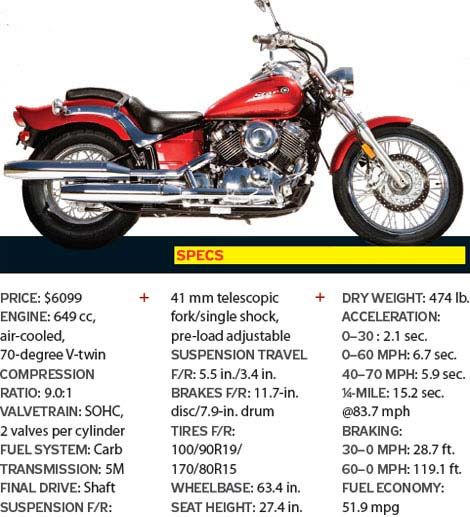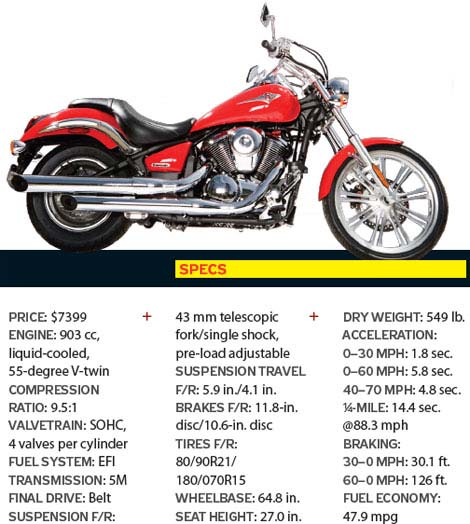Cruiser Bikes With Best Mileage

Motorcycles have an alter ego. On the outside, a husky cruiser bike may look like the two-wheel equivalent of a gas-guzzling muscle car. But despite the big chrome pipes, fat rear tire and bulging V-twin engine, bikes are fantastically fuel-efficient machines.
Even the heaviest, most powerful models deliver hybridlike economy. The smallest ones sip fuel at a pace that would make a Prius owner jealous. So a cool-looking, fun-to-ride cruiser can become a very unlikely and appealing alternative to a hybrid. Who says motorcycles are just weekend fun?
The best-selling of these fuel-efficient cruisers live in the rather nebulous middleweight class. Broadly ranging from 500 cc to 1000 cc, these bikes all pack traditional V-twin engines, pumped-up styling and loads of comfort. The middleweights are lighter, lower and much easier to ride than the big boys. So they won't overwhelm first-time riders. Yet many are rewarding enough for old pros, too. Best of all, these bikes are some of the sweetest bargains in motorcycling.
We gathered up five middleweight contenders from Yamaha (Star), Harley-Davidson, Honda, Kawasaki and Suzuki, and rode them nearly 350 miles through some of Southern California's best roads and worst traffic. Professional rider Danny Coe ran each bike through our battery of acceleration and braking tests at Auto Club Raceway in Pomona. And we brought along a seasoned passenger to test each bike's capability for two-up touring. Often it takes big torque to turn our heads. But in this test, we found that the smaller bikes had enough power, efficiency and comfort to impress.
Yamaha V Star Custom

On paper, the 649 cc V Star appears to be the runt of the litter. But the Star was the leader in several important criteria for first-time or budget-conscious riders. The Star stickers at barely over $6000. So for the price of another bike in the test, you could get a new V Star and, say, a Shoei helmet and Dainese leather jacket and still have a few hundred left over for gas money. Smaller or less experienced riders will welcome the Star's low weight, too. At 474 pounds, it was the most svelte in the test. That lack of heft and an amazingly light clutch effort combine to make the V Star easy to ride and maneuver in heavy traffic. But as small as the V Star is, it had, as they say, a big personality. Yep, the V Star has attitude. The bike rumbles and shakes at idle. And it has that classic cruiser profile reminiscent of a seven-eighths-scale Harley-Davidson Softail. Like the Harleys of the past, the V Star's 649 cc V-twin is air-cooled, is fed by a pair of carburetors and has a manual choke. Remember those? At highway speeds, the handlebars fed through a bit more vibration than the other bikes. It wouldn't be our first choice for a trip cross-country. And for larger riders, the close-coupled position was cramped. The Star was no star at the dragstrip, yet it was able to outgun the larger displacement Honda to 60 mph. More important, the Star had the second-best brakes of the bunch. Better still, our test rider proclaimed that the brake feel on the Star was the best in the test. On the open road, the Star returned nearly 52 mpg. And our test passenger found the rear pillion the most comfortable. In all, the V Star is a great deal for a new rider looking to save some Âpetrol and get a head-turning bike for weekend rides.
Harley-Davidson Sportster XL 883

The Sportster is the mechanical equivalent of that perfectly antiqued vintage motorcycle jacket—like the leather one Peter Fonda wore in Easy Rider or the waxed cotton Belstaff jacket that used to hang in Steve McQueen's closet. The Sportster makes anyone who rides it instantly cool in an old-school kind of way. The riding position, suspension design and styling all hearken back to the 1960s. Oddly, the Harley is less like a traditional cruiser than the others. The short 60-in. wheelbase and upright, almost forward-leaning riding position make the Sportster closer to a standard bike. That sporty riding position, combined with higher-clearance foot pegs, brought the Harley one twist of the throttle away from the nimble Suzuki in the canyons. Indeed, the Harley and Suzuki were in many ways archrivals. At the track the Hog effectively tied for second place with the Boulevard M50 in the quarter-mile. Sometimes Âsmaller bikes don't sound as throaty and rich as the big-bore bikes. Not the case here. The classic 883 cc V-twin burbled that distinctive Harley "potato-potato" sound. And you can hear every one of those pushrods clacking away as it idles. It's a neat experience. One tester dubbed the Sportster the "flying jukebox"—an appropriate handle. On the highway, the Harley didn't feel as relaxed and wasn't as cushy as some. On this bike you're alert and ready for action instead of laid-back and mellow. But face it, when you're jousting with Peterbilts, that's probably okay. The Harley had the tallest seat height in the test. So shorter folks might want to choose one of the lower-slung models in the Sportster lineup. In terms of refinement, the Hog was outmatched by the Japanese bikes. Still, the old-time rumbles and vibrations and the visceral personality of this classic bike are what make it such a charmer.
Honda Shadow Spirit 750 C2

Squint your eyes and the Spirit, like the V Star, looks like a much larger bike. The illusion comes from the long and low front fork and tidy rear proportions as well as that big 21-in. front wheel. Of the smaller bikes in the test, many thought the Honda had the cleanest styling. The $7099 Spirit ($6799 in black and silver) had the second smallest motor of the group. But it did have the best braking performance. And good brakes are crucial for all riders—especially those new to motorcycling. The 745 cc V-twin may not be a dragstrip superstar, but like all Honda motorcycle engines, it was a real smoothie. And the handlebars were vibration-free at highway speeds. To most buyers in the market for a middleweight, that smoothness is more important than all-out speed. Shorter riders will dig the Spirit, too. It had the lowest seat of the bunch. A rider who stands less than 5 ft. 5 in. can flat-foot this bike at a stoplight. Yet tall riders were not cramped after a day of riding. The Honda was a talented performer in the canyons. But if you'd like to bring a passenger along, better get an aftermarket rear pillion. It was the least comfortable here. The Honda did not have the cornering clearance of the Suzuki or Harley, but it inspired confidence. If fuel economy is the deciding factor, look no further than this 750. On our fuel-economy loop, the Honda returned 54.5 mpg—the best here. We imagine the Spirit could achieve closer to 60 mpg with a conservative right hand. And as far as we're concerned, riding a fuel-sipping Spirit to work every day is a really fun way to reduce that CO2 footprint.
Kawasaki Vulcan 900 Custom

The Kawasaki is the light heavyweight in this grouping of middleweights. The 903 cc V-twin was a burly beast at the dragstrip, trouncing every other bike. Seasoned riders—those who can handle the size, heft and awesome power—can best appreciate the Vulcan. Crank the throttle wide open on straightaways and the Vulcan rewards you with a deep throaty exhaust note. Not surprisingly, it was one of our favorites. When the time came to swap bikes, more than one staffer quickly migrated to the Vulcan for the highway stints. The Kawi's instant torque, low vibration and smooth ride made it the best long hauler of the bunch. The motor doesn't seem like it's even working until you hit 80 mph. The passenger pad was one of the best for comfort. And everyone appreciated that fuel gauge. All bikes should have one. Our informal design roundtable voted the Kawasaki tied with the Harley for baddest-Âlooking bike of the test. The Vulcan takes a heaping dollop of inspiration from the custom chopper scene, with a raked front fork and a beautifully machined 21-in. front wheel. The whole bike looked much more expensive than its $7399 price tag. Downside? Well, the ÂVulcan's Jesse James-like front and rear tires combined with low cornering clearance made for peg scraping in tighter canyons. And that skinny tire was prone to lockup in our brake testing. Solution? Get the Vulcan 900 Classic with a more traditional front tire. The Vulcan was the most expensive bike we tested. But when you account for the thrills, refinement and craftsmanship, in many ways the Kawasaki is the best buy of the bunch.
Suzuki Boulevard M50

Cruisers are not meant to carve canyons. And that should be especially true of these lower-priced bikes, because speed and handling poise are expensive to engineer. Right? Well, if that's the case, then Suzuki must take a loss on every Boulevard M50. This bike is built to run. It was the quickest to 60 mph and had the second quickest quarter-mile times. And, with only 805 cc to move the bike, that was impressive. But the Suzuki returned the second worst fuel economy. Still, can nearly 50 mpg really be considered poor fuel economy? Conveniently, Suzuki equips the M50 with a real fuel gauge, too. The M50 was the clear champ when it came to hustling up our favorite back roads in the Santa Monica Mountains. The bike tackled curves intuitively and confidently and made for a relaxing but swift ride thanks to the sporty inverted front fork and large front tire. We found ourselves pushing the Suzuki much harder than the other bikes simply because it felt so natural. On the highway, the M50 is comfy for larger riders. And the level of vibration at speed was much less than the Yamaha's or Harley's. Plus the M50 had one of the best passenger pillions in the test. Best of all, the M50 has a tough-looking stance. This is, in essence, a bargain muscle bike.
Ben Stewart Ben is a lifelong enthusiast of anything with wheels.
This content is created and maintained by a third party, and imported onto this page to help users provide their email addresses. You may be able to find more information about this and similar content at piano.io
Cruiser Bikes With Best Mileage
Source: https://www.popularmechanics.com/cars/motorcycles/a3927/4268696/







Tidak ada komentar:
Posting Komentar